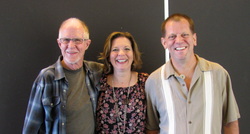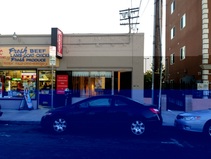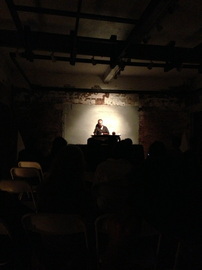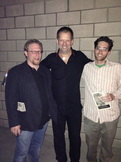APRIL IN CALIFORNIA
San Diego

with Phil Larson and Susan Narucki
The tour began in San Diego. UCSD has long been a mecca of new music, even in the vocal area. Walking down the hall with the teaching studios is like attending a “who’s who” of contemporary music performers. For many years, Carol Plantamura and Phil Larson were the voice professors. I was able to meet Phil for the first time on this trip and it was a joyous encounter. We are hoping to solicit repertory for two low male voices, in order to combine our bags of tricks at the service of worthy composers. Susan Narucki was hired five years ago when Carol Plantamura retired. I had the good fortune to be hired by Susan to make an appearance in a performance class. Only a pianist had prepared a piece, so I gave him some advice on interpretation. When a Q&A format was yielding few results, I decided to initiate an improvisation. I asked the students (two pianists, a group of percussionists, a group of singers and a cellist) to begin with the vocalists singing into the piano, with the sustaining pedal down, and the percussionists playing the piano as a percussion instrument. They were free to take it where they wished from this point of departure. After the improvisation, I asked each student who was not playing or singing to advise the improvisers, group by group. In this manner, all of the students were able to either play, sing or play the role of the composer. Susan sang with the vocalists. The grand finale was one big vocal improvisation with everyone. One non-singer produced some extraordinary male damping and the performance class performed.
|
Los Angeles
This entire tour was born, because I met Veronika Krausas (USC composition professor and head of the theory department) and Jeffrey Holmes (Chapman composition professor) after my Monday Evening Concert of Kurtág’s Pas à Pas in December, 2011. All three of us are friends and admirers of lutenist, guitarist and my former student Mike Kudirka . In Los Angeles, I was fortunate enough to stay in the guest apartment of the Uniacks. Before beginning my own events, I was able to hear my former student Timur Bekbosunov perform with members of the Los Angeles Philharmonic in Disney Hall. He sang beautifully, despite the weakness of the piece, a “cheap imitation” of the musical Rent, pawned off as contemporary art music. I was shocked to see that several of the winners o the LA Phil composition contest were the “son of…”. Nepotism is alive and well in Southern California! The next day, I did a master class on French music for the voice students at USC. They performed admirably, living up to the reputation of one of the most celebrated voice programs in the United States. It was nice to work on something besides new music and explore the challenges of the “e muet”, how to sing nasal vowels, the supremacy of text and other difficulties specific to French music. The voice faculty at USC gave me a warm welcome and I felt truly honored. The following day, Mark and I repeated the recital with Jeffrey Holmes’ piece at Chapman. The program is uncompromising, bleak and relentless, but the audience stuck with it. My wonderful family from San Diego drove up and it was a lovely evening . Jeff lives in an incredible spot in the Topanga canyon and composes highly structured, powerful music.( listen HERE). The piece is in ancient Norse. Mark played the difficult piano part of Jeff’s piece and the solistic Debussy accompaniments with aplomb. On Tuesday, I returned to Cal State L.A., invited by composer John Kennedy. I sang a recital of baroque music there in the 1980s, produced by musicologist Olga Termini, who was in attendance this time as well, and a concert including French music and a world premiere of John’s in 2007. This time I did a lecture on “From Whispers to Cries,” playing examples from Bruno Walter’s live recording of Don Giovanni and Chaliapin singing the “Clock Scene” from Boris Godunov (Mussorgsky again!). The cherry on the cake was my own live performance of Berio’s Sequenza III, inspired by my meeting with my friend Berberian and Berio’s daughter Cristina a couple of days earlier. The Cal State students and faculty (voice, theater and composition) were the most motivated of all, asking insightful questions on a variety of topics.
|
I began my Los Angeles events with a lecture for Veronika’s composers at USC. I gave a quick resume of my upcoming book The Techniques of Singing for Bärenreiter Verlag and fielded questions. On the following day, I gave a radio interview for John Schneider, a gifted musician, Partsch partisan and new music friend at KPFK radio station. I also did a master class for the singers at Calarts, where I was Jacqui Bobak’s sabbatical replacement in 2007. It was good to work with the students, who were quite keen and had a lot of questions. A soprano performed Stripsody and two female vocalists sang a nice piece by Kaaija Saariaho. One of them, Kirsten Wiest, will be studying with Susan at UCSD in the fall, so my trip had already come full circle. The master class was organized by Paul Berkolds, a new music baritone and loyal supporter of mine (thank you, Paul). The first concert was a recital with the excellent pianist Mark Robson, who lived down the hall from me in French House at Oberlin when I was a freshman. We performed a recital with Mussorgsky’s masterpiece No Sun, a Debussy/Verlaine group, an Ives group and the premiere of Jeffrey Holmes’ Moon of Fate. The first runthrough was at the Uniacks for a group of their friends. Composer Anne Le Baron was kind enough to come down from Calarts to hear us . The Uniacks have a true “salon musical.” The following night, I sang the world premiere of Veronika Krausas’ Alchemy Suite to a text by Quintan Ana Wikswo. The venue was a loft space on Western and 2nd, in Koreatown. On the outside, you would never guess that there is a performance space there. The context was a recital called East Meets West with music by Asian composers and Western composers influenced by Asia. Veronika’s piece is inspired by Tibetan shamanism and turtle bone prophesies . The event was well-attended and the venue atmospheric. Veronika is a Canadian composer who has written an opera and creates in a collaborative manner that often incorporates theatrical elements and video. I sang the third part of her triptych at a VOXNOVA concert in Paris in March. The week was still not over! On Monday, the day after the Chapman recital, I did a lecture for the students. A mixture of composers and singers was attentive and asked interesting questions about interpretation. The same day, we recorded Veronika’s piece for an upcoming DVD by Quintan. This will be released when we perform the piece in Céret, in the South of France, in August. |
Santa Barbara
|
|
My final stop was at UCSB, where my friends Curtis Roads and Clarence Barlow invited me to sing Stockhausen’s Havona in their Primavera Festival.
It was an evening of highly diverse electroacoustic music, featuring a piece for saxophone and tape by Clarence, a work by James Dashow, who was in attendance, and a laptop orchestra of hoodie clad students and faculty. Havona worked its magic and it was a delight to sing this piece by my musical father. More performances of Havona are planned for Belgium and New Zealand later this year. The stay was enhanced by a room with a view of the Pacific Ocean, an excellent Japanese meal after the concert and the company of the friendly Santa Barbarans, including my childhood friend UCSB philosophy professor Matthew Hanser, my cousin Jay, his girlfriend and Veronika, all of whom drove up from L.A. |
|
I have been performing in the L.A. area since the 1980s, when I sang Händel’s La Resurrezione with L.A. Baroque and Strauß’ Ariadne auf Naxos at Long Beach Opera. It was exciting to see how Southern California has become a crucible for new music. Many small concert series and university programs combine to make it one of the most interesting parts of the globe for creativity. Most importantly, the scene is growing. Although the lethargy of today’s generation of students was sometimes present, I was mostly struck by their vitality compared to their peers in other parts of the U.S. and the world.
|



